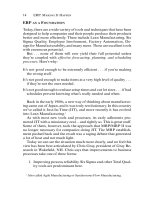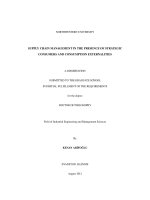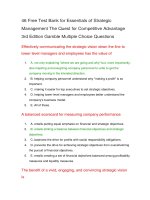The Nature of Strategic Management
Bạn đang xem bản rút gọn của tài liệu. Xem và tải ngay bản đầy đủ của tài liệu tại đây (147.09 KB, 48 trang )
Chapter 1
The Nature of Strategic
Management
Strategic Management:
Concepts and Cases. 9th edition
Fred R. David
PowerPoint Slides by
Anthony F. Chelte
Western New England College
Fred R. David
Ch. 1-1
The Nature of Strategic
Management
• A global perspective is a matter of survival for
businesses.
• E-commerce is a vital strategic management
tool.
• The natural environment is an important
strategic issue.
Fred R. David
Ch. 1-2
Strategic Management Achieves
Organizational Success
Process of Integrating:
–
–
–
–
–
–
management
marketing
finance/accounting
production/operations
research and development
computer information systems
Fred R. David
Ch. 1-3
Three-Stage Process
Strategy Formulation
Strategy
Implementation
Strategy Evaluation
Fred R. David
Ch. 1-4
Strategy Formulation
Vision & Mission
Opportunities & Threats
Strengths & Weaknesses
Long-Term Objectives
Alternative Strategies
Strategy Selection
Fred R. David
Ch. 1-5
Strategy Formulation
Issues include:
– What new businesses to enter
– What businesses to abandon
– How to allocate resources
– Expand operations or diversify
– Enter international markets
– Merge or form joint venture
– Avoidance of hostile takeover
Fred R. David
Ch. 1-6
Strategy Implementation
Annual Objectives
Policies
Employee Motivation
Resource Allocation
Fred R. David
Ch. 1-7
Strategy Implementation
Action Stage of strategic management:
– Most difficult stage
– Mobilizing employees and managers
– Interpersonal skills are critical
– Consensus on pursuing goals
Fred R. David
Ch. 1-8
Strategy Evaluation
Internal Review
External Review
Performance Measurement
Corrective Action
Fred R. David
Ch. 1-9
Strategy Evaluation
Final stage of strategic management:
– All strategies subject to future modification
– Success today is no guarantee of success
tomorrow
– Success creates new and different problems
– Complacency leads to demise
Fred R. David
Ch. 1-10
Prime Task of Strategic
Management
According to Peter Drucker…
The prime task is to think through the
overall mission of a business
Ask the question:
What is our Business?
Fred R. David
Ch. 1-11
Integrating Intuition and Analysis
The strategic management process
attempts to organize quantitative and
qualitative information under
conditions of uncertainty.
Fred R. David
Ch. 1-12
Integrating Intuition and Analysis
Intuition based on:
– Past experiences
– Judgment
– Feelings
Useful for decision making
– Conditions of great uncertainty
– Conditions with little precedent
Fred R. David
Ch. 1-13
Integrating Intuition and Analysis
Intuition and judgment
– Management at all levels
– Analyses are influenced
Analytical thinking and intuitive thinking
– Complement each other
Fred R. David
Ch. 1-14
Adaptation to Change
Organizations must monitor events
– On-going process
– Internal and external events
– Timely changes
Fred R. David
Ch. 1-15
Adaptation to Change
Rate and magnitude of changes
– Increasing dramatically
• E-commerce
• Demographics
• Technology
• Merger-mania
– Effective Adaptation
• Long-run focus
Fred R. David
Ch. 1-16
Adaptation to Change
Key strategic-management questions:
– What kind of business should we become?
– Are we in the right fields?
– Should we reshape our business?
– What new competitors are entering our
industry?
– What strategies should we pursue?
– How are our customers changing?
Fred R. David
Ch. 1-17
Key Terms
Strategists
– Most responsible for success or failure of
an organization
– Various job titles:
•
•
•
•
•
•
Chief executive officer
President
Owner
Chair of the Board
Executive Director
Entrepreneur
Fred R. David
Ch. 1-18
Key Terms
Vision Statement
– What do we want to become?
Mission Statement
– What is our business?
Fred R. David
Ch. 1-19
Key Terms
External Opportunities and Threats
– Significantly benefit or harm the organization in the
future.
– Include the following trends:
•
•
•
•
•
•
•
Economic
Social
Cultural
Demographic Environmental
Political, legal, governmental
Technological
Competitive trends
Fred R. David
Ch. 1-20
Key Terms
External Opportunities and Threats
– Largely beyond the control of a single
organization.
– Basic tenet of strategic management
• Strategy formulation to:
– Take advantage of external opportunities
– Avoid or reduce impact of external threats
Fred R. David
Ch. 1-21
Key Terms
Environmental Scanning
– Industry Analysis
• Process of conducting research and
gathering and assimilating external
information
Fred R. David
Ch. 1-22
Key Terms
Internal Strengths and Weaknesses
– Controllable activities performed
especially well or poorly.
– Arise in functional areas of the business:
•
•
•
•
•
•
Management
Marketing
Finance/accounting
Production/operations
Research & development
Computer Information Systems
Fred R. David
Ch. 1-23
Key Terms
Determining Internal Factors:
– Financial ratios
– Measuring performance
– Industry averages
– Survey data
Fred R. David
Ch. 1-24
Key Terms
Long-term objectives:
– Mission-driven pursuit of specific results
more than one-year out.
– Essential for organizational success
•
•
•
•
•
State direction
Aid in evaluation
Create synergy
Focus coordination
Basis for planning, motivating and controlling
Fred R. David
Ch. 1-25









